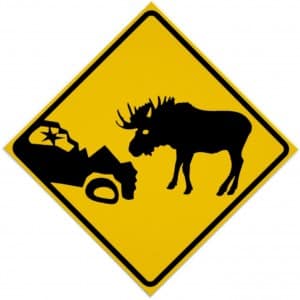 (Statewide) — Motorists are urged to use extra caution this time of year when traveling roadways in Southcentral, Interior, and other regions where moose are common. Long nights and short, often dimly lit winter days make the animals especially difficult to spot, increasing the danger of moose-vehicle collisions.
(Statewide) — Motorists are urged to use extra caution this time of year when traveling roadways in Southcentral, Interior, and other regions where moose are common. Long nights and short, often dimly lit winter days make the animals especially difficult to spot, increasing the danger of moose-vehicle collisions.
“The majority of our road kills occur during the winter months,” said Kenai Area Wildlife Biologist Jeff Selinger. “Decreased visibility due to lack of daylight, icy roads, and moose movement patterns all contribute to the increased collision rates we see at this time of year.”
Visibility hazards are further compounded when accumulating snow forces moose into lowland areas, often around highway corridors where travel is easier and food sources more exposed. The combination can be deadly for moose and motorists alike when vehicles traveling at normal highway speeds collide with the animals that may weigh between 500 and 1,000 pounds.
To help prevent collisions with moose, the Alaska Department of Fish and Game suggests drivers practice the following safe winter driving habits:
- Clean vehicle headlights and windshields. Moose can be difficult to see and most moose-vehicle accidents occur at dawn and dusk when the light is low and moose are most active.
- Drive according to weather conditions. Reduced driving speeds at night and in adverse weather allow motorists better opportunity to spot moose near roadways and provide more time to react should animals bolt into the road.
- Be alert. Deliberately and continuously scan for wildlife on both sides of the road and along road corridors and medians.
- Stay tuned. Cow moose crossing or standing near roads are often accompanied by calves; reduce speed when moose are spotted and look for additional animals that may be crossing behind the first.
- Observe Signs. Watch for highway warning signs marking high moose-vehicle collision areas and known moose crossing areas such as moose ranges or refuges; remain especially alert for a few miles before and beyond those areas.
- Back Off. Increase the distance between you and the car in front of you to allow for greater braking distances and reaction time.
- Other Clues. Watch for flickering in the headlights of oncoming traffic or against reflective signs that may be caused by an animal crossing in front of that vehicle.
Motorists involved in or who witness moose-vehicle collisions should contact Alaska State Troopers. Injured moose should be reported to the nearest Department of Fish and Game office during normal business hours, online at adfg.alaska.gov (Report a Wildlife Encounter), or to the troopers outside normal business hours.
